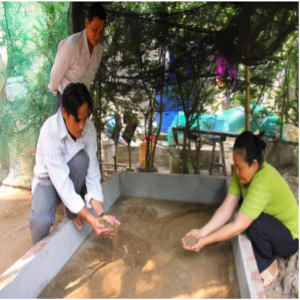Do Thi Le, a farmer from Thanh Thoi A Commune, Vietnam innovatively incorporated calcium worms into her poultry feed, significantly reducing feed costs and boosting her poultry flock’s growth and productivity. After attending a training class, she successfully raised calcium worms, using them to replace expensive conventional feeds. This approach not only cut her feed expenses by VND 1 million (USD 40) per month but also improved the quality and yield of her poultry products, leading to an increased income of VND 7 million (USD 275) from egg sales. Le’s success with calcium worms inspired her to expand her operation and promote the technique to other farmers, highlighting its benefits for both poultry nutrition and sustainable waste management.
Do Thi Le has developed a mixed animal husbandry model, maintaining a herd of three beef cattle, a flock of 30 chickens, and a flock of 10 ducks. She uses leftover food to raise calcium worms, providing a nutritious feed source for her chickens and ducks.
Le, a dedicated farmer and active contributor to the Thanh Thoi A Commune Farmers’ Union, was selected to participate in a farmer training class on calcium worm-raising techniques. Before the training, she spent about VND 1.3 million (USD 50) per month on animal feed including rice and corn for her chickens and ducks. Learning that raising calcium worms could significantly reduce her feed costs, she was eager to try the new method.
Initially, Le attempted to raise calcium worms using leftover food but faced challenges due to incorrect application of the technique, resulting in disappointing outcomes and family objections. Determined to succeed, she made a second attempt, this time meticulously following the training instructions. Her efforts paid off, and she achieved successful results. Her family and neighbors, impressed by her success, recognized the benefits of the method and expressed their willingness to adopt it as well.
Le shared that before joining the project, she was unaware of the benefits of calcium worms. The training class enlightened her on the characteristics of these worms, motivating her to try raising them. Armed with technical guidance and calcium worm eggs from the project, she began her first batches and harvested them as feed for her chickens. To raise calcium worms, Le and her family constructed two 5m² tanks on their land. Each raising batch lasts about two weeks, yielding 80 kilograms of mature worms. Her chickens and ducks eagerly consumed the nutritious worms, which significantly improved their growth and overall health.
As a result of incorporating calcium worms into their diet, Le has been able to save VND 1 million (USD 40) per month on feed costs. Her chickens grew faster and produced higher-quality meat, while her ducks laid larger eggs that sold at higher prices. The enhanced productivity and product quality have led to an increase in her family’s income by VND 7 million (USD 270) from the sale of chicken and duck eggs compared to previous years.
Le enthusiastically shared the benefits of raising calcium worms and has actively promoted this method to her neighbors and other communities. She highlighted that raising calcium worms is straightforward and requires minimal effort. Besides using leftover food, pig manure, and chicken manure are also effective feed sources for calcium worms.
Recognizing the benefits, Le plans to expand her calcium worm tanks and increase her poultry numbers. In the long term, she aims to integrate fish farming with calcium worm cultivation. She also envisions establishing a collective group to share the calcium worm farming technique and purchase mature worms from members for sale to other farmers, creating a new income stream for local farmers.
Admired by her neighbors for her willingness to help and provide technical support, Le collaborates closely with the Thanh Thoi A Commune Farmers’ Union. She is a pioneering farmer, eager to adopt new techniques in animal husbandry and advance the rural development movement. Le believes that small actions can lead to significant changes and emphasizes that raising calcium worms can help farmers reduce feed costs, manage manure, and boost their income, making it a worthwhile endeavor for all. Calcium worms offer double benefits: they serve as an excellent source of animal feed and act as an “organic machine” for processing animal manure and leftover food. Additionally, calcium worm frass can be used to feed redworms or processed into organic fertilizer for plants. Having successfully raised calcium worms myself, I’m confident you can achieve the same results.
The technical training provided Le with the essential knowledge to try this method. However, it is crucial to follow the instructions meticulously, as failure to do so can lead to poor results, as Le initially experienced.




Comments are closed